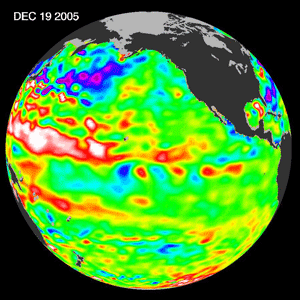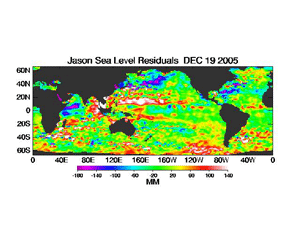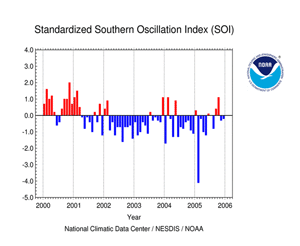COOLING SSTs CONTINUE TO DEVELOP IN THE
EQUATORIAL PACIFIC BASIN
|
|
Sea-Surface
Temperatures (SSTs) and
Mixed-Layer Conditions: Since April 2005, the SSTs across the equatorial Pacific Ocean have cooled in the different Niño regions. The coldest anomalies have developed along the South American coast, as reflected in the SST observations from the Niño 1+2 region. Temperatures in the upper ocean and mixed-layer have also decreased, as a layer of anomalously cold water (~1 to ~2°C below normal) has persisted in the central and eastern equatorial Pacific. The monthly mean SSTs continued to cool over the past month, with a December SST anomaly of -0.79°C (-1.42°F) in the Niño 3.4 Index region in the central equatorial Pacific Ocean, and -0.02°C (-0.036°F) in the Niño 4 Index region in the western equatorial Pacific Ocean (map of Niño regions). For the most recent ocean surface temperature conditions, please see the loop of satellite-derived weekly SST anomalies for December 2005. At the end of December 2005, the 3-month running mean of the Niño 3.4 Index continued to decrease below the long term mean, but remained above NOAA's -0.5°C threshold for classifying the conditions in the equatorial Pacific Ocean as a La Niña. (NOTE: A running 3-month mean SST anomaly below -0.5°C in the Niño 3.4 region is one indicator that a La Niña is occurring. For the official NOAA classification scheme, please see NOAA's El Niño/La Niña Index Definition and see the CPC ENSO Diagnostic Discussion for NOAA's latest official assessment of ENSO conditions). |
|
|
Equatorial
Zonal Winds (U-Component Winds) and Sea-Level
Topography: The easterly trade winds remained above-normal during December across the near-equatorial Pacific, which enhanced equatorial upwelling in the mixed-layer. Stronger-than-average easterly trade winds were reflected in the monthly zonal wind anomalies along the equator, with the largest departures from average of -1 to -2 m/s in the western Pacific region. Satellite altimetry of ocean surface topography from the NASA/JPL Jason-1 satellite over the Pacific basin and global oceans is shown to the left. A recent overpass of the Jason-1 satellite on December 19th showed a large region north of the equator in the western North Pacific where positive sea-level anomalies were present. Despite the development of this anomaly in the western North Pacific, no large-scale sea level anomalies had been observed along the equatorial zone at the end of 2005. |
|
|
Outgoing
Longwave Radiation (OLR): The map to the left shows the spatial pattern of global OLR (in W m-2) observed by satellite during December. In the western Pacific, positive OLR anomalies associated with suppressed convection were observed near the dateline, while negative OLR anomalies associated with enhanced convection were observed over Indonesia. During the October-December period a large east-west oriented region of positive OLR anomalies was observed immediately north of the equator along the Inter-Tropical Convergence Zone (ITCZ), and therefore tropical convection was anomalously below average in the central and eastern equatorial Pacific during the past 3 months. The monthly averaged OLR Index remained postive in December, with a mean value of +1.5 averaged across an area centered over the dateline in the western Pacific (between 160° E and 160° W). The OLR Index has shifted sign several times over the past year, although the index has been positive for the past 4 months and has shown an increasing trend. Note that high frequency variability in OLR is typically associated with the Madden-Julian Oscillation (MJO) (MJO related convective activity propagates west to east in the near-equatorial region from the Indian Ocean into the Pacific Ocean approximately every 30-60 days). The latest MJO activity can be seen in CPC's graphs of Daily MJO Indices. |
| Southern
Oscillation Index (SOI): The standardized SOI remained slightly negative in December, with a monthly averaged index value of -0.2. At the end of 2005, the SOI had been negative during 6 months, although it switched signs several times with no definitive longer-term trend. However, since March of 2005 the SOI has remained either neutral or near-neutral, which reflects the lack of any large-scale fluctuations in mean sea-level pressure (MSLP) across the equatorial Pacific basin. |
Additional Links
- ENSO Monitoring
- NOAA El Niño / La Niña Index Definition
- NOAA's Pacific Marine Environmental Laboratory (PMEL):
- NOAA's Climate Prediction Center (CPC):
- NOAA's Physical Science Laboratory
- NASA/JPL Ocean Surface Topography from Space
- Australian Bureau of Meteorology (BoM) Climate Driver Update
- IRI - International Research Institute
 NOAA's National Centers for Environmental Information
NOAA's National Centers for Environmental Information










